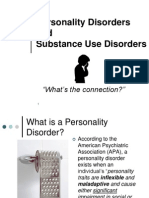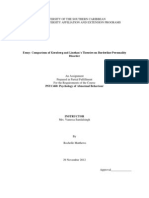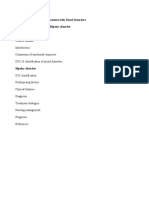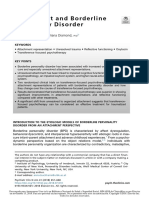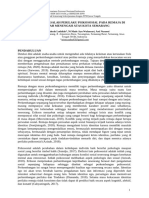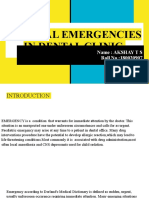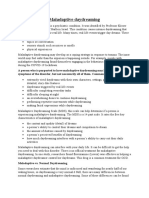Histrionic Personality Disorder
Uploaded by
Marietta JuaniteHistrionic Personality Disorder
Uploaded by
Marietta JuaniteHistrionic personality disorder
Histrionic personality disorder (HPD) is defined by
the American Psychiatric Association as a personality
disorder characterized by a pattern of excessive attention-
seeking emotions, usually beginning in early adulthood, including
inappropriately seductive behavior and an excessive need for
approval. Histrionic people are lively, dramatic, vivacious,
enthusiastic, and flirtatious. HPD is diagnosed four times as
frequently in women as men.[1] It affects 2–3% of the general
population and 10–15% in inpatient and outpatient mental health
institutions.[2]
HPD lies in the dramatic cluster of personality disorders.[3] People
with HPD have a high need for attention, make loud and
inappropriate appearances, exaggerate their behaviors and
emotions, and crave stimulation.[3] They may exhibit sexually
provocative behavior, express strong emotions with an
impressionistic style, and can be easily influenced by others.
Associated features include egocentrism, self-indulgence,
continuous longing for appreciation, and
persistent manipulative behavior to achieve their own needs.
Signs and symptoms[edit]
People with HPD are usually high-functioning, both socially and
professionally. They usually have good social skills, despite
tending to use them to manipulate others into making them the
center of attention.[4] HPD may also affect a person's social
and/or romantic relationships, as well as their ability to cope with
losses or failures. They may seek treatment for clinical
depression when romantic (or other close personal) relationships
end.[citation needed]
Individuals with HPD often fail to see their own personal situation
realistically, instead dramatizing and exaggerating their
difficulties. They may go through frequent job changes, as they
become easily bored and may prefer withdrawing
from frustration (instead of facing it). Because they tend to
crave novelty and excitement, they may place themselves in risky
situations. All of these factors may lead to greater risk of
developing clinical depression.[5]
Additional characteristics may include:
Exhibitionist behavior
Constant seeking of reassurance or approval
Excessive sensitivity to criticism or disapproval
Pride of own personality and unwillingness to change, viewing
any change as a threat
Inappropriately seductive appearance or behavior of a sexual
nature
Using somatic symptoms (of physical illness) to garner
attention
A need to be the center of attention
Low tolerance for frustration or delayed gratification
Rapidly shifting emotional states that may appear superficial or
exaggerated to others
Tendency to believe that relationships are more intimate than
they actually are
Making rash decisions[4]
Blaming personal failures or disappointments on others
Being easily influenced by others, especially those who treat
them approvingly
Being overly dramatic and emotional[6]
Influenced by the suggestions of others[7]
Some people with histrionic traits or personality disorder change
their seduction technique into a more maternal or paternal style
as they age
You might also like
- Mentalization Bades Treatment For Pathological Narcissism.No ratings yetMentalization Bades Treatment For Pathological Narcissism.27 pages
- Children of Mothers With Borderline Personality Disorder (BPD)100% (1)Children of Mothers With Borderline Personality Disorder (BPD)6 pages
- Young Adult Narcissism - A 20 Year Longitudinal StudyNo ratings yetYoung Adult Narcissism - A 20 Year Longitudinal Study10 pages
- What I Mean When I Say I Dont Know How I AmNo ratings yetWhat I Mean When I Say I Dont Know How I Am5 pages
- Personality Disorders: Pathophysiology and Risk FactorsNo ratings yetPersonality Disorders: Pathophysiology and Risk Factors5 pages
- Borderline Personality Disorder Implications in Family and Pediatric Practice 2161 0487.1000122No ratings yetBorderline Personality Disorder Implications in Family and Pediatric Practice 2161 0487.10001226 pages
- SCREENING - ASPERGERS - Australian Scale For Aspergers in Adults - DraftNo ratings yetSCREENING - ASPERGERS - Australian Scale For Aspergers in Adults - Draft7 pages
- Diagnosing Borderline Personality DisorderNo ratings yetDiagnosing Borderline Personality Disorder12 pages
- Child Psychiatry - Assessment and TestingNo ratings yetChild Psychiatry - Assessment and Testing24 pages
- Psychiatry - Cluster B Personality DisordersNo ratings yetPsychiatry - Cluster B Personality Disorders69 pages
- Origins of Disosiative Personality DisorderNo ratings yetOrigins of Disosiative Personality Disorder39 pages
- Antisocial Personality Disorder - Epidemiology, Clinical Manifestations, Course and Diagnosis - UpToDateNo ratings yetAntisocial Personality Disorder - Epidemiology, Clinical Manifestations, Course and Diagnosis - UpToDate17 pages
- Kluft, R.P. - Clinical Approaches To The Integration of PersonalitiesNo ratings yetKluft, R.P. - Clinical Approaches To The Integration of Personalities33 pages
- Signs and Symptoms May Include:: Cluster B Anti Social Personality Disorder100% (1)Signs and Symptoms May Include:: Cluster B Anti Social Personality Disorder2 pages
- Pervasive Instability: A Borderline Personality Disorder Zine100% (2)Pervasive Instability: A Borderline Personality Disorder Zine24 pages
- FIRST EVER Cold Therapy Certification Seminar in Vienna! REGISTER NOW!100% (1)FIRST EVER Cold Therapy Certification Seminar in Vienna! REGISTER NOW!5 pages
- The Intersectionality of Bipolar Disorder With Borderline Personality DisorderNo ratings yetThe Intersectionality of Bipolar Disorder With Borderline Personality Disorder14 pages
- Race, Ethnicity, Gender, and Class The Sociology of Group Conflict and Change 8th Edition Joseph F. Healey 2024 Scribd Download100% (3)Race, Ethnicity, Gender, and Class The Sociology of Group Conflict and Change 8th Edition Joseph F. Healey 2024 Scribd Download39 pages
- An Introduction To Theories of Personality 5th Edition by Robert B Ewen0% (1)An Introduction To Theories of Personality 5th Edition by Robert B Ewen6 pages
- Attachment and Borderline Personality DisorderNo ratings yetAttachment and Borderline Personality Disorder18 pages
- Schizophrenia Mental Illness Relationships: Types of PsychotherapyNo ratings yetSchizophrenia Mental Illness Relationships: Types of Psychotherapy3 pages
- Cluster C Avoidant Personality Disorder (In Depth)No ratings yetCluster C Avoidant Personality Disorder (In Depth)5 pages
- Dissociative Identity Disorder A Pathophysiological PhenomenonNo ratings yetDissociative Identity Disorder A Pathophysiological Phenomenon3 pages
- Almost Untreatable Narcissistic Patient - KernbergNo ratings yetAlmost Untreatable Narcissistic Patient - Kernberg38 pages
- Treating Borderline States in Marriage: Dealing with Oppositionalism, Ruthless Aggression, and Severe ResistanceFrom EverandTreating Borderline States in Marriage: Dealing with Oppositionalism, Ruthless Aggression, and Severe ResistanceNo ratings yet
- The Pain and Anguish of Living with a Narcissist: See the Truth Within You, Not the Lies of a NarcissistFrom EverandThe Pain and Anguish of Living with a Narcissist: See the Truth Within You, Not the Lies of a NarcissistNo ratings yet
- Regional Trial Court Branch 30: - VersusNo ratings yetRegional Trial Court Branch 30: - Versus5 pages
- Intestinal Obstruction in Paediatrics - James Gathogo100% (2)Intestinal Obstruction in Paediatrics - James Gathogo21 pages
- Medical Emergency in Paediatric Dental ClinicNo ratings yetMedical Emergency in Paediatric Dental Clinic75 pages
- NURS FPX 6026 Assessment 1 Analysis of Position Papers For Vulnerable PopulationsNo ratings yetNURS FPX 6026 Assessment 1 Analysis of Position Papers For Vulnerable Populations6 pages
- Abramowitz-Jacoby-2015-Annual-Review-of-Clinical-Psych-2015No ratings yetAbramowitz-Jacoby-2015-Annual-Review-of-Clinical-Psych-201524 pages
- SF 8 Learner Basic Health and Nutrition ReportNo ratings yetSF 8 Learner Basic Health and Nutrition Report34 pages
- Pneumothorax: - Hitesh Rohit (3 Year B.P.T.)No ratings yetPneumothorax: - Hitesh Rohit (3 Year B.P.T.)22 pages
- Severe Sensitive Axonal Neuropathy and Oropharingeal DysphagiaNo ratings yetSevere Sensitive Axonal Neuropathy and Oropharingeal Dysphagia3 pages
- 1.3.1.Διάκριση Νοητικής Αναπηρίας Και ΔΑΦNo ratings yet1.3.1.Διάκριση Νοητικής Αναπηρίας Και ΔΑΦ10 pages
- Full Handbook of Clinical Psychiatry - A Practical Guide 2nd Edition Varuni de Silva Ebook All Chapters100% (4)Full Handbook of Clinical Psychiatry - A Practical Guide 2nd Edition Varuni de Silva Ebook All Chapters53 pages






















